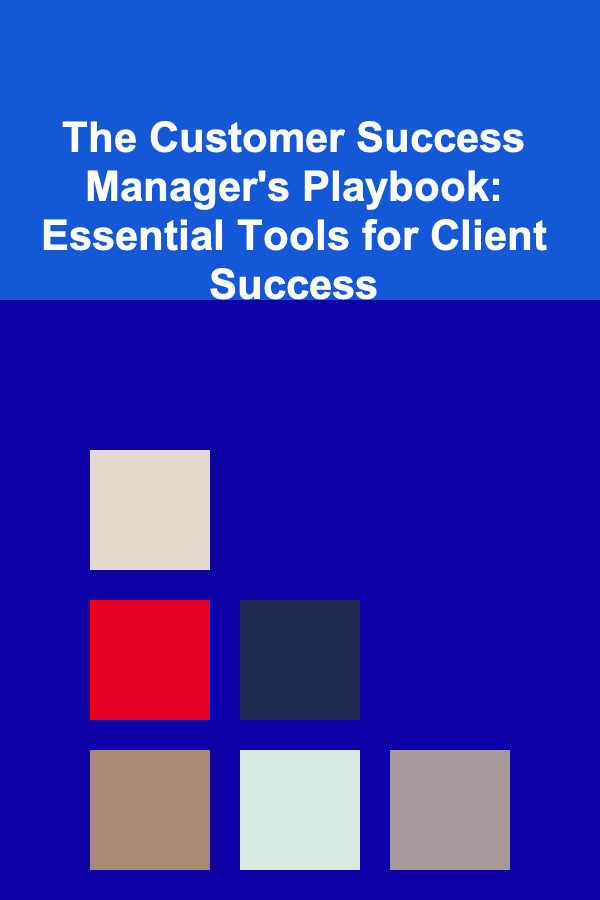
The Customer Success Manager's Playbook: Essential Tools for Client Success
ebook include PDF & Audio bundle (Micro Guide)
$12.99$6.99
Limited Time Offer! Order within the next:

In today's fast-paced business world, Customer Success Managers (CSMs) are increasingly seen as integral players in a company's success. They are tasked with ensuring that customers not only use a product or service but also achieve measurable success through it. The role of a CSM extends far beyond traditional customer service -- they are strategic partners, facilitators of customer goals, and advocates for a mutually beneficial long-term relationship.
One of the most important components in achieving customer success is leveraging the right set of tools. These tools empower CSMs to streamline workflows, enhance communication, monitor customer health, and ultimately foster stronger relationships. In this playbook, we will dive deep into the essential tools that Customer Success Managers should use to ensure client success at every stage of the customer journey.
Customer Relationship Management (CRM) Software
At the heart of any CSM's toolkit is a CRM system. A CRM is more than just a database of customer information -- it's a central hub for managing all interactions with customers, tracking progress, and maintaining long-term relationships.
Why CRM Is Essential
CRMs allow CSMs to organize customer data, monitor communication history, and track progress toward goals. This makes it easier to provide personalized support, anticipate customer needs, and ensure that no opportunities for growth are overlooked.
Key Features to Look for in a CRM:
- 360-Degree Customer View: Integrates all relevant customer information (e.g., contact details, purchase history, interactions, feedback).
- Automation and Workflow Management: Automates repetitive tasks like follow-up emails, reminders, and meeting scheduling.
- Customer Segmentation: Helps segment customers based on factors like business size, industry, or engagement level.
- Analytics and Reporting: Provides data-driven insights on customer behavior, health, and potential churn risks.
Popular CRM Tools for CSMs:
- Salesforce: Offers comprehensive customer relationship management features with powerful reporting and automation tools.
- HubSpot: A user-friendly platform that offers sales, marketing, and service tools integrated into one system.
- Zendesk: Primarily known for customer support, Zendesk integrates customer interactions with helpdesk functionality.
Customer Health Scoring Tools
To proactively manage customer relationships and identify when a client is at risk of churning, CSMs must monitor customer health. This can be done through customer health scoring tools, which track metrics that reflect the customer's engagement level, satisfaction, and overall experience with the product or service.
Why Health Scores Matter
Customer health scores provide a quick snapshot of how customers are interacting with your product or service. By tracking various metrics, CSMs can prioritize their efforts on customers that need attention before small issues escalate into major problems. This helps in maintaining a high retention rate and reducing churn.
Key Metrics to Track:
- Usage and Engagement: Frequency of product usage, feature adoption, or logins.
- Support Requests: Frequency and severity of customer support tickets.
- Customer Satisfaction (CSAT) Scores: Direct feedback from customers via surveys or interviews.
- Renewal Rates: Tracking whether the customer is likely to renew their contract based on previous engagement and interactions.
Popular Tools for Health Scoring:
- ChurnZero: A robust tool for tracking customer health and automating customer success workflows.
- Gainsight: Provides detailed insights into customer engagement and health, offering predictive analytics to identify churn risks.
- Totango: Uses customer health scores to segment accounts, allowing for more targeted customer success strategies.
Customer Feedback and Survey Tools
Customer feedback is invaluable for improving customer success efforts and product development. Survey tools help CSMs collect direct insights from customers, which can be used to tailor strategies and services to meet their needs.
Why Feedback Matters
Listening to customers' opinions helps identify pain points, areas of improvement, and opportunities for growth. Feedback not only gauges customer satisfaction but also allows CSMs to understand their customers' evolving needs and how well the product is meeting those needs.
Key Features to Look for in Feedback Tools:
- Customizable Surveys: Design surveys tailored to the specific goals or concerns of the customer.
- Real-Time Data Collection: Gather feedback from customers instantly after interactions or product usage.
- Actionable Insights: Analyze feedback to extract key trends and insights that inform decisions.
Popular Survey and Feedback Tools:
- SurveyMonkey: A well-known platform that allows businesses to design and distribute surveys quickly.
- Typeform: Provides visually appealing surveys that lead to better customer engagement.
- Qualtrics: A robust platform for gathering in-depth customer feedback across multiple touchpoints.
Communication and Collaboration Tools
Effective communication is at the core of customer success. CSMs need to be able to interact with customers and internal teams seamlessly. Whether it's through email, chat, video calls, or collaborative documents, communication tools are indispensable for day-to-day operations.
Why Communication Tools Are Essential
Clear and constant communication with both customers and internal stakeholders is vital for providing exceptional customer service. Collaboration tools ensure that all team members are aligned on customer needs and expectations, while communication tools enable CSMs to provide timely responses and updates to customers.
Key Features to Look for in Communication Tools:
- Multi-Channel Support: Ability to handle communication via email, chat, video conferencing, etc.
- Integrated Calendars: Schedule and manage meetings and calls.
- Real-Time Collaboration: Allow teams to work on shared documents or platforms for project tracking.
Popular Communication and Collaboration Tools:
- Slack: A widely used communication tool for real-time conversations within teams.
- Zoom: A leading video conferencing tool that enables face-to-face interactions with customers and internal teams.
- Microsoft Teams: Integrates communication and collaboration features into one tool, providing chat, file sharing, and video calls.
Onboarding and Training Platforms
A successful customer relationship starts with an effective onboarding process. CSMs should use onboarding and training tools to ensure that new customers are successfully introduced to the product and are able to maximize its value from day one.
Why Onboarding and Training Tools Are Important
An efficient onboarding process helps customers get up to speed quickly, reducing frustration and increasing the chances of long-term engagement. Training tools help CSMs provide ongoing education and empower customers to use the product effectively, leading to higher satisfaction and retention rates.
Key Features to Look for in Onboarding Tools:
- Interactive Tutorials: Step-by-step guides or walkthroughs that help customers understand how to use the product.
- Automated Onboarding Sequences: Pre-scheduled email campaigns or messages that guide customers through the initial stages of product adoption.
- Knowledge Base Integration: Easy access to FAQs, tutorials, and troubleshooting guides.
Popular Onboarding and Training Tools:
- WalkMe: A leading digital adoption platform that helps guide users through complex software with in-app instructions.
- Whatfix: A user-friendly onboarding tool that creates interactive product tours and in-app messaging.
- Userlane: A tool designed to create interactive product walkthroughs that improve customer onboarding.
Customer Success Analytics Tools
Data is a crucial component of customer success. CSMs need to track various performance metrics, such as customer engagement, product usage, satisfaction scores, and retention rates, to assess their performance and refine their strategies.
Why Analytics Tools Are Vital
Customer success analytics tools provide deep insights into the effectiveness of customer success programs and highlight areas for improvement. They help CSMs make data-driven decisions, improve customer engagement, and identify risks early on.
Key Metrics to Track:
- Product Adoption Rates: How quickly customers are adopting new features.
- Net Promoter Score (NPS): A measure of customer satisfaction and likelihood to recommend the product.
- Customer Lifetime Value (CLV): The total revenue a customer is expected to generate over their relationship with the company.
- Churn Rate: The percentage of customers who stop using the product over a specific period.
Popular Analytics Tools:
- Power BI (Microsoft): A business analytics service that provides interactive visualizations and business intelligence capabilities.
- Tableau: A leading data visualization tool that allows CSMs to create custom reports and dashboards.
- Google Analytics: A powerful tool for tracking user engagement with digital products and services.
Conclusion
A Customer Success Manager's role is both dynamic and strategic, requiring a variety of tools to ensure that customers are achieving the value they expect from a product or service. By leveraging the right set of tools, CSMs can improve customer onboarding, track health and engagement, collect feedback, foster effective communication, and use data to optimize strategies for long-term success.
Choosing the right tools requires an understanding of the specific needs of your customers and the goals of your company. However, by implementing a combination of CRM systems, health scoring tools, feedback platforms, communication solutions, training tools, and analytics software, CSMs can set the stage for lasting customer relationships, driving both satisfaction and retention.

How to Create a Cozy, Clutter-Free Bedroom with Smart Storage Tips
Read More
How to Find Long-Term Clients for Your Data Entry Business
Read More
How to Maintain Your Home's HVAC System for Year-Round Comfort
Read More
How to Use Tapping (EFT) for Emotional Release
Read More
How to Use Transparent Storage for Quick Item Identification
Read More
Why Minimalism is Key to Home Organization
Read MoreOther Products

How to Create a Cozy, Clutter-Free Bedroom with Smart Storage Tips
Read More
How to Find Long-Term Clients for Your Data Entry Business
Read More
How to Maintain Your Home's HVAC System for Year-Round Comfort
Read More
How to Use Tapping (EFT) for Emotional Release
Read More
How to Use Transparent Storage for Quick Item Identification
Read More